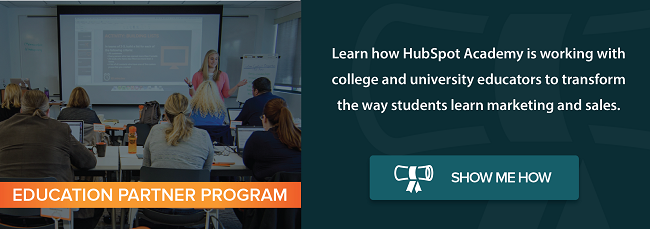
When I graduated from college, I had no idea what I wanted to do. Sure, I knew that I wanted, you know, to be employed. I knew I wanted to put my English degree to good use. And I knew I wanted some aspect of the written word to be involved. But what did that look like?
“I dunno,” would’ve been my honest answer.
It’s not that I received anything less than a great education. In fact, I have almost nothing but good things to say about my undergrad alma mater. It’s just that the school had fallen into the same problem that most universities do — the coursework, while excellent, didn’t address what has turned into a pandemic marketing and sales skills gap.
Granted, that was more years ago than I’d like to admit, before much of the technology essential to marketing and sales jobs was as prevalent as it is today. But according to research conducted by Boston Consulting Group, companies still continue to fall short on the level of digital skills on their marketing teams. And as the consumption of products, services, and information continues to rely more on technology — that’s not good. 
But what are you supposed to do about it? You’re busy enough trying to do what you can to make up for this skills gap. How could you possibly also resolve how to actually fill it? Well, as it turns out, you have two major options: To build talent, and to buy it. Don’t worry — neither option is as overwhelming or as expensive as it sounds. In fact, both really boil down to providing the right resources for both your current and incoming employees. What do those look like? We’ve got a few ideas.
How to Get Better Marketing Talent
When You’re Buying
Bringing in new hires is not a simple process. There are the measurable variables, like the cost of onboarding — an average of over $4,000 per new employee, for most companies — and expensive employee turnover in a number of industries. So when you’re looking to add someone new to your team, you want to make sure it’s a good decision.
Part of feeling certain of a new hire is understanding what kind of training and experience that person has received, especially when it comes to new graduates. A shortage of internships available undergraduates limits their opportunities for experience. So, how can you be certain that a candidate can fill your marketing team’s needs — especially if the right skills aren’t being taught in the classroom?
That’s where you come in. See, the recruiting process goes both ways — just as you want to make sure a candidate is the right fit, you want to do everything you can to look attractive as an employer. And those efforts could include providing learning resources to prospective employees.
For example, when I was looking for opportunities in business school, I would come across many hiring pages from companies that listed the many reasons why I should work there — great benefits, great culture, and opportunities for growth, to name a few. But there was something missing. Nowhere on these hiring sites were there tips for what I could do to strengthen my candidacy for that particular environment.
So if you really want to attract the best talent, follow the mantra, “Help me help you.” It only requires a few steps.
1) Make a list of desired attributes — beyond the job description.
When I first began to look into working for HubSpot, one thing that really stood out to me was the fact that the company has a Culture Code. It didn’t just teach me about how I would be valued as an employee, but it also illustrated the must-have qualities of people who get hired here. That immediately made me realize how much I wanted to work for a company like this one.
When you begin recruiting talent, ask yourself what your company’s own Culture Code would look like. It might not be for everyone, and that’s okay — you’re trying to get candidates who are the best fit to stick around. Give them the right information to help them know who they are.
2) Collaborate with educational institutions.
This step goes beyond simply signing up for a booth at a career fair. I wouldn’t know anything about planning a higher education curriculum, but I get the impression that it’s not easy — which is why these skills gaps might still exist. However, as a marketer, I have a better idea of what kind of knowledge my own team might be seeking, and I’m happy to share it.
If you’re in the same boat, it could be worthwhile to reach out to the career development departments of nearby colleges and universities to find out what you can do to help bring some of that knowledge to the student body. Mind you, we’re not suggesting that you ask for a teaching position or request to be paid for a special lecture.
Rather, work with the school’s administration to see if you can offer a complimentary workshop on the skills that you’re seeking the most. While you might have them, you’re only one person — so see what you can do to share them. It’s an investment of time and resources, but it doesn’t come without a return. If you brand the opportunity properly, it’s a way to stand out in the minds of future job applicants, who might ultimately apply for work with you, therefore filling those gaps. Plus, it reinforces your own reputation as an expert in that particular area, and now that you’ve helped others build those skills, you’ll be able to recruit the talent necessary to meet resulting demand.
3) Share learning resources with applicants — and educators.
While you might not have the bandwidth to undertake something like teaching a workshop, there are still ways to help bring skills and knowledge to your future hiring pool. That’s why your hiring site should be built with two audiences in mind: The applicants themselves, and the people who will be teaching them.
For applicants
In addition to listing the general skills and characteristics that you seek in your new hires, it might be helpful to direct them to the resources that can help them gain that knowledge and become better candidates.
Free online courses are a great place to begin. Do some research on the ones available for the skill gaps you need to fill the most — for example, this EdX course in Digital Branding and Engagement, or this one on High Level Digital Marketing Strategy For Small Businesses from Udemy. Plus, a pre-existing knowledge of inbound marketing is always helpful, and getting inbound certified is free with HubSpot Academy.
For educators
When it comes to providing resources to educators, sometimes identifying the skills gaps is a big first step. Understanding what your strongest candidates need to know in order to succeed in the digital marketing landscape can help develop the tools for teaching the accompanying skills. Outline what they are, and give examples of the type of job titles and responsibilities that require them.
And just as there are online learning resources for applicants — there are actually some for educators, too, like HubSpot Academy’s Education Partner Program. Its mission is to help educators teach inbound marketing, and to connect their students with opportunities to apply both in the real world. Plus, the criteria for becoming an Education Partner doesn’t really go beyond the scope of what’s already required of most institutions — it’s a college, university, or institute that teaches Inbound with HubSpot Academy’s resources, or uses HubSpot software in their classes.
When You’re Building
Please forgive the cop out, but we’ll tell you right now — the efforts for building the right kind of talent within your current team isn’t really all that different than buying it.
There are many situations when one option might be better than the other one — that all depends on your budget, your scope of work, or your current client and customer demands. But when it comes to the latest and greatest skills in cultivating your current employees, all you really have to do is provide the same resources for them that you would for external applicants.
It won’t look identical. But when you go about building or revamping a hiring page like we described above, look into building an intranet or wiki that provides many of the same learning resources that can help employees build their skills and progress in their careers — without leaving your company. After all, we’ve already gone over the high cost of employee turnover. Helping to build the right internal growth opportunities for your current team can prevent those costs from becoming necessary.
Create a place where your employees can see the types of roles or skills gaps you’re trying to fill, and let them know where they can learn how to fill them. Just as you might provide a list of these resources for external applicants or lead workshops for them, do the same for your current staff. Even if someone isn’t looking into changing roles, digital marketing knowledge can be applied to a broad range of projects.
And if they do progress — well, now you know how to attract the best people to replace them in their former positions.
Talent Show
Trying to ensure that you’ve got the best people to meet your company’s demands is never an easy process. There’s so much to consider, from culture fit to necessary skills. As we said — you want to be certain, and for good reason.
But with the above-outlined steps, it doesn’t have to be quite as daunting as you might think. You can proactively take measures to attract the best talent — whether that’s coming from a pool of recent grads, or from your current team.
What are your preferred ways getting the best marketing talent? Let us know in the comments.
![]()
Powered by WPeMatico








